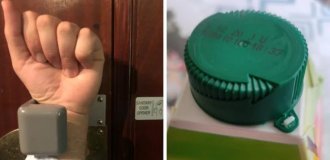How to make sushi at home (26 photos + text)
I really like sushi. True, I don’t usually cook myself; I prefer to eat in restaurants. Making sushi at home is not as difficult as it might seem at first glance. And it doesn’t matter that it won’t turn out too beautiful the first time. This will not make them any less tasty :) Over time, you will acquire the necessary skills and be able to make sushi easily and playfully. On average, the cooking process takes an hour and a half. Basic types of sushi: 1. Nigiri (compressed sushi): small, compressed finger-sized sticks of rice with a piece of fish on top. Sushi bars are usually served in pairs. 2. Maki (rolls): a combination of rice with any seafood and vegetables, rolled in a sheet of nori seaweed. Subsequently, the roll is cut into pieces. 3. Chirashi sushi (separate sushi): the most common type in Japan. The rice is placed into small containers and topped with a random combination of seafood and vegetables. 4. Oshi-sushi (pressed sushi): Cooked or marinated fish is placed in the bottom of a small container, which is then filled to the brim with rice. A weight is placed on top of the rice. After some time, the workpiece is taken out, turned over with the fish up and cut into pieces. 5. Mixed sushi: any other that does not fall into the above categories. For example, fukuza sushi is thin omelette squares used to wrap rice. Today we will learn how to prepare two types of sushi: nigiri and maki.

Required Products
1. Sushi rice (with short, rounded grains)

Some products close up:

Rice vinegar (su). It is highly advisable to use Japanese rice vinegar, which is mild and sweet. Chinese and especially Western brands are stronger and sour, and can overpower the delicate taste of sushi with their aroma. Mitsukan rice vinegar is the most suitable and is sold in many Asian stores.
Nori (seaweed). Usually sold in bags of 5-10 pieces, they are dark, crispy sheets measuring 20 x 18 cm. Used in making maki (rolls). The color is dark green and almost black. The black ones are more expensive, but also have a stronger aroma.
Raw fresh fish: salmon fillets (sake) and tuna (maguro). Under no circumstances should fish be frozen! It is advisable to buy something specially designed for sushi in Japanese stores, marked “sushi grade”.
Flying fish roe (masago). Arbitrary component. Mainly used to decorate the top of rolls or to coat the outside of the rolls when the rolls are cooked with the rice facing out (ura-maki).
Filling for rolls, any combination. For example, crab sticks, strips of avocado, cucumber and cream cheese. Additionally, you can use special Japanese mayonnaise (the regular one is too strong).
Preparing sushi rice
Rice, not fish, is the most important ingredient in sushi. The taste of the entire dish depends on whether it was prepared correctly. We are looking for Japanese style rice, with short, rounded grains. A regular long one won't work, it's very dry and therefore holds too much water. Recommended varieties: Nishiki, Kahomai, Maruyu, Kokuho and Minori.
1. Washing the rice. Typically, one cup of rice is enough for two people. But taking into account the fact that you will get a taste for it in the process of eating sushi prepared by yourself, it is better to proceed from the calculation of two cups.
2. Drain almost all the water. Stir again and squeeze the rice with your hand, this time firmly, but gently, without breaking, for 10 seconds. Fill with fresh water, squeeze, drain. Repeat one or two more times, the water should become almost clear. Drain.
3. Cooking rice. Place the washed rice in a deep pan. For each cup of rice, add 250 ml of cold water (in our case 500 ml). Close the lid, set the heat to maximum and quickly bring to a boil (takes about 5-7 minutes). Then, set the heat to minimum and leave for 12 minutes. After this time, the water will be completely absorbed into the rice and small ventilation holes will appear on its surface. Without removing the lid, remove the pan from the heat and let it brew for another 15 minutes.
4. While the rice is steeping, prepare a dressing for it. For two cups of rice you will need 50 ml of rice vinegar, 30 g of sugar and 10 g of salt. Dissolve sugar and salt in vinegar. You can pre-naked it slightly
roar (very lightly!).
Nigiri
br>While the rice is cooling, we need to cut the fish. There are 5 different cutting techniques for different types of sushi. But for nigiri, the technique of cutting fish at an angle is most suitable.
It is advisable to take a fish preparation of a rectangular shape, about 10 cm in length and 2.5 in height.
Forming nigiri. By this time the rice should have cooled down or be barely warm. Prepare a small plate of wasabi and vinegar water (tezu) to wet your hands (just pour boiled water into a bowl with a narrow mouth and add a couple of tablespoons of rice vinegar). When forming nigiri, your hands must always be wet, otherwise it will not work.
Carefully turn the nigiri over so that it rests on the fingertips of your left hand, fish side up. Now move it to the base of your fingers, while squeezing from the ends. Press the fish tightly into the rice.
Using the index finger of your right hand, scoop up a little wasabi (without releasing the rice from your palm) and lightly coat the piece of fish. Place rice on top. Using your left thumb, lightly press the top of the rice, leaving an almost imperceptible indentation. Now change hands and press more firmly onto the entire surface of the rice with the index and middle fingers of your right hand.
Nigiri is ready! Over time, you will learn to do them quickly and correctly. Make sure that the rice is not “pinched” and that the fish slices are always larger than the rice preparation and seem to cover it.
Rolls (maki)
Rolls - "twisted sushi" - are formed using a bamboo mat (makisu). The filling can be anything you want. Usually this is any seafood in combination with vegetables (avocado, cucumber), Japanese mild mayonnaise or cream cheese. Using a mat, the rice and filling are rolled into a sheet of nori seaweed.
1. Thin rolls (hoso-maki). Thin rolls, about 2.5 cm in diameter, usually contain only one ingredient. To make them you will need half a sheet of seaweed (fold the sheet in half and cut with scissors). This half will make 6 pieces of sushi.
For rolls, simply cut the fish into narrow strips, or use the leftovers from cutting nigiri. Place half of the seaweed on the mat, shiny side down. Wet your hands with vinegar water. Take about 4 heaping tablespoons of rice and spread it over the surface of the seaweed. A free strip of about 1 cm should be left from the top edge, about 0.5 cm from the bottom. The height of the rice layer should be about 7 mm. Take your time, distribute the rice evenly, constantly wetting your hands. Using your index finger, rub a strip of wasabi down the middle of the rice. Top with toppings such as sliced tuna.
Align the bottom edge of the seagrass with the edge of the bamboo mat. Now, holding the filling in place, lift the edge of the mat using your thumbs as shown in the photo above. Continue lifting the mat up and forward until the edge rests on the opposite side of the seaweed. Fold the edge of the mat up, roll the roll back and forth and squeeze it a little inside the mat. Press the ends of the roll with your fingers if any rice falls out. Set the roll aside on a smooth surface and proceed to making the next one.
2. Thick rolls (futo-maki). Thick rolls, 5 cm in diameter, can contain up to 5 components. To make them, take a whole sheet of seaweed and place it on the mat, shiny side down. Wet your hands with vinegar water and spread the rice evenly over the seaweed, leaving about 2 cm free on the top side. If desired, coat the rice with mild mayonnaise.
While holding all ingredients, lift the edge of the mat using your thumbs and continue to lift it up and forward until the edge of the mat touches the opposite edge of the seaweed. Then, fold the edge of the mat up and roll the roll forward. Lightly squeeze it inside the mat, press it down with your fingers from the ends if the rice falls out. Set aside on a smooth surface and proceed to make the next one.
3. How to cut rolls. Take a sharp knife and dip the tip into vinegar water. Then, turn it with the tip up so that the water runs over the entire surface of the knife and equals
wetted it considerably. This will allow the knife to easily pass through the sticky rice without getting stuck in it.
As a result, you should get something similar to what is shown in the photo. When making rolls, especially futo-maki, you need to make sure that you don’t get a “snail” of seaweed inside. Such rolls are considered substandard, and show that the manufacturer has violated the principles of rolling rolls, and has not yet completely mastered the art of sushi making :) Inside the rolls there should be nothing except rice with ingredients (as in the rolls in the lower right corner in the photo).
Place the sushi on beautiful trays and pour soy sauce into ceramic cups. You can dissolve a little wasabi in it if you want a more spicy sensation. You can also add a pickled ginger leaf to the sauce, but traditionally it is used to cleanse the palate of the taste of the previous piece of sushi. Grab the sushi with chopsticks, dip it into the sauce, let it soak for a few seconds and put it in your mouth.
Bon appetit!






















